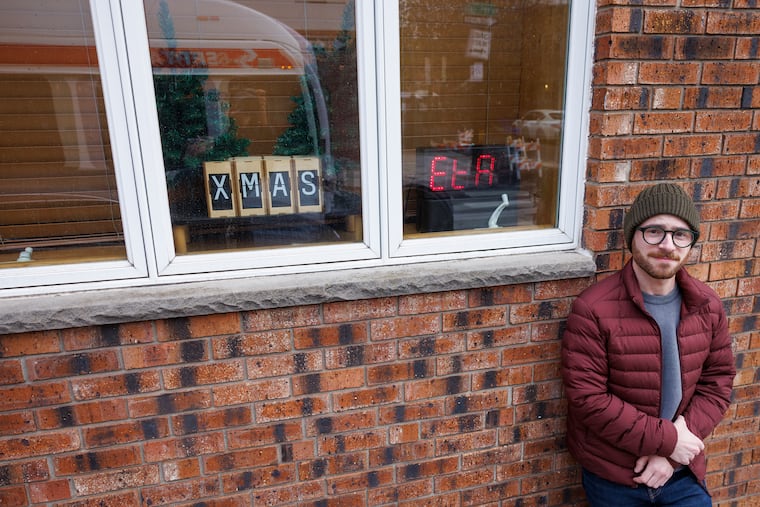A guerilla public servant built a SEPTA bus clock for his front window in South Philly
Over three weeks, Max Goldberg and a machine assistant tinkered with SEPTA’s publicly available data and an old clock.

Max Goldberg really loves the bus.
“It’s quiet, it’s clean, it’s aboveground; there’s so many nice things about the bus,” he explained.
He also loves a project. Recently, he was waiting at the bus stop across the street from his home in South Philadelphia when he got his latest brain itch. Forget staring at your phone or stepping into traffic to peer anxiously down the street. What if he and his fellow passengers could simply look at the front window of his house to find out when the next bus was going to arrive?
He had his mission: to figure out a way to link SEPTA’s real-time bus tracker with an old sports display clock that he bought years ago from a thrift store.
He is not a professional coder, just a DIY enthusiast. But in Philadelphia, where Benjamin Franklin once captured lightning in a jar, all dreams are possible. So Goldberg turned to Claude, an AI assistant, for help.
“I was screaming to myself internally, like I know this should be possible,” Goldberg, who is 32, said.
On nights and weekends over the course of the next three weeks, he and his machine assistant tinkered with SEPTA’s publicly available data and the old clock. He attached a $5 computer chip, called an ESP32, to the clock’s top, plugged the display into a power outlet and connected it to his home WiFi.
As with most scientific discoveries, progress at first was slow. Sometimes the clock would light up with a series of random numbers, or flash all 8’s, or glow with upside-down letters. But then the code started to click.
“He’ll come out of his office and he’ll just go, ‘I’ve had a breakthrough!’” said Monica Mainville, Goldberg’s fiancé. “Every time I come downstairs, he’s like, ‘there’s news!’”
It is not the first project she’s witnessed. In 2016, one of the couple’s first dates was a clandestine visit to 30th Street Station, where Goldberg was making a short film about the final days of the station’s iconic mechanical flipboard and needed “unpaid labor under the thinly veiled guise of a date,” Mainville joked. Her job was “standing there and keeping an eye out for 30th Street Station security because we had no permit to film.”
The two are getting married next month.
Finally, the code was completed and the clock lit up with the time, the bus route number, and an ever-updating ETA, pulling the data from SEPTA every 10 seconds. Goldberg installed it in his front window so it could serve its purpose, tucking away the many black wires so it didn’t look, as he put it, like “a timed bomb.”
“That’s the first one I’ve seen. It’d be nice if there was more,” said Christine Rhodes, 34, seeing the clock as she waited for the bus recently.
Goldberg posted a video of his creation to the Philadelphia Reddit page, where it quickly rocketed to the second-most popular post of all time. (The most popular is a post insulting former Sen. Pat Toomey.)
People chimed in from all over the country, thanking him, asking how to replicate it, and begging him to work for SEPTA. One of the early responders also warned that if someone missed their bus they might throw a brick through Goldberg’s window, but so far that has not come to pass.
“This is like when Jonas Salk invented the polio vaccine and gave away the patent rights so the vaccine could be freely available to everyone! Well, not quite that but … close,” one commenter wrote.
Goldberg, who owns a video production company and works at a tech startup, was inspired by similar stories of what he calls “guerilla infrastructure”: when ordinary people enact short-term, cheap, easy-to-copy solutions to urban planning problems, without government permission.
He particularly loves the story of Richard Ankrom, a Los Angeles artist who designed and installed a rogue freeway sign in 2001 to solve the problem of a poorly marked exit. (Ankrom matched the font and design of the real freeway signs so well that his stayed up for more than eight years.)
Elsewhere in the country, guerilla public servants have planted gardens in vacant lots, installed bike lanes without permission, and built benches at bus stops.
Of course, individual actions are no solution for collective problems: Goldberg’s clock was mounted during furious negotiations by SEPTA and its largest employee union to avert a strike, while SEPTA officials were warning of an impending “death spiral” in which the transit system would raise fares and cut services starting in January. Josh Shapiro stepped in Friday with a temporary fix, redirecting $153 million in federal highway funds to SEPTA.
But still — a little clock, even in a big broken world, was something.
“If I can do anything to make public transit a little less annoying for people, and try to make public transit more appealing, I feel like it’s my duty,” Goldberg said. “I just want to do it.”
Next he wants to figure out a way to share the process so other people can easily replicate it in their own windows.
On a recent morning, a cluster of people waited for the bus across the street from his house as his clock’s ETA blinked red in his front window.
“Check it out. Zero. And there it is,” Goldberg said, as the bus trundled down the narrow street. “It actually worked.”